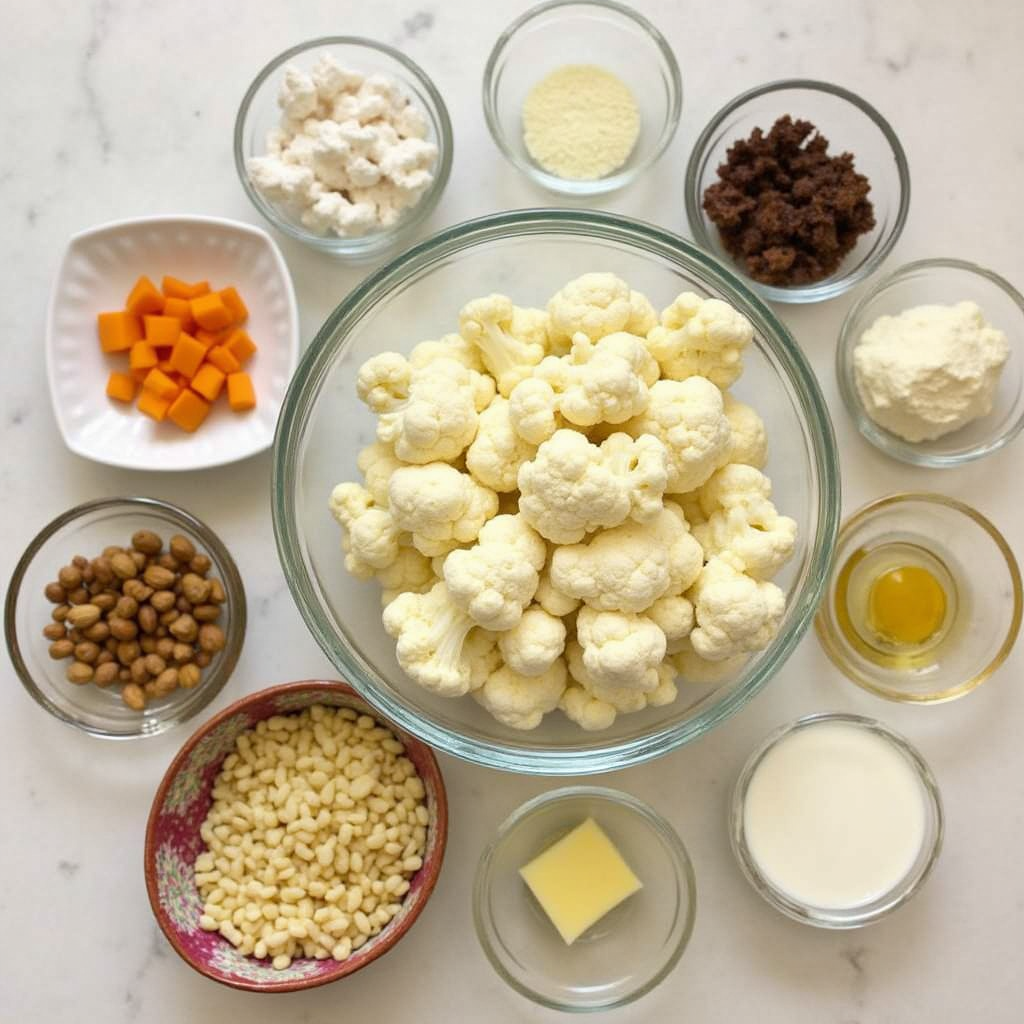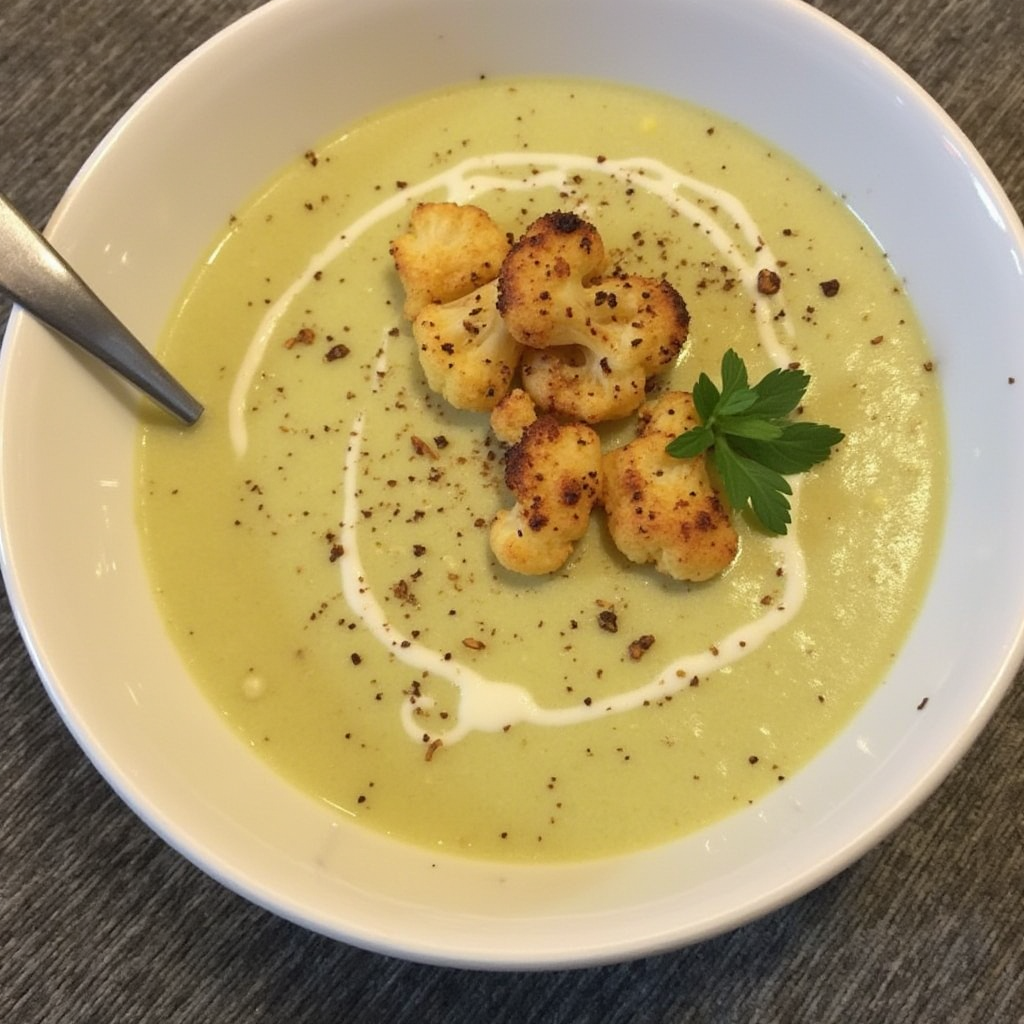Roasted cauliflower soup has gained popularity as a flavorful, nutritious dish that’s easy to prepare and deeply satisfying. The roasting process enhances the natural sweetness of the cauliflower, creating a rich base for the soup. Whether you’re looking for a cozy winter meal or a light summer lunch, roasted cauliflower soup is versatile enough to fit any occasion. Its creamy texture makes it feel indulgent, even though it’s packed with wholesome ingredients. This article will guide you through the steps of making the perfect roasted cauliflower soup, with a focus on flavors, nutrition, and serving suggestions.
In this comprehensive guide, we’ll explore the key benefits of cauliflower, the best ingredients to use, and expert tips on roasting cauliflower to perfection. By the end, you’ll be ready to serve a delicious bowl of roasted cauliflower soup to your family or guests.
The Nutritional Benefits of Cauliflower
Cauliflower is an incredibly nutritious vegetable, making it a great choice for soups. Rich in vitamins C and K, as well as fiber, cauliflower supports overall health. A single serving of roasted cauliflower soup provides a wealth of nutrients without adding excessive calories. This makes it an ideal option for those looking to maintain a balanced diet while still enjoying a flavorful meal.
Some of the key nutritional benefits of cauliflower include:
- High in antioxidants, which help fight inflammation
- Low in carbohydrates, making it a keto-friendly choice
- Rich in fiber, promoting digestive health
- A good source of choline, supporting brain health
- Packed with vitamin C, boosting the immune system
When combined with other fresh ingredients, roasted cauliflower soup becomes a powerhouse of nutrition, perfect for supporting a healthy lifestyle.

Ingredients for the Best Roasted Cauliflower Soup
Choosing the right ingredients is essential for creating a flavorful and nutritious roasted cauliflower soup. The quality and freshness of your ingredients will directly impact the taste and texture of the final dish. Here’s a list of the key ingredients you’ll need:
- 1 large head of cauliflower, cut into florets
- 1 onion, diced
- 3 cloves of garlic, minced
- 4 cups of vegetable broth
- 1 cup of coconut milk or heavy cream for creaminess
- 2 tablespoons of olive oil
- Salt and pepper to taste
For added flavor, you can also include:
- A pinch of smoked paprika
- Fresh thyme or rosemary
- A squeeze of lemon juice for brightness
These simple ingredients come together to form a hearty and flavorful base for your roasted cauliflower soup, ensuring that each bite is bursting with richness.
Step-by-Step Guide to Making Roasted Cauliflower Soup
Making roasted cauliflower soup is a straightforward process, even for novice cooks. Follow these simple steps to create a perfectly roasted and blended soup:
- Preheat the oven: Set your oven to 400°F (200°C) to get ready for roasting the cauliflower.
- Prepare the cauliflower: Toss the cauliflower florets with olive oil, salt, and pepper. Spread them evenly on a baking sheet.
- Roast the cauliflower: Roast the cauliflower for 25-30 minutes, or until it’s golden brown and tender.
- Sauté the aromatics: While the cauliflower is roasting, heat olive oil in a large pot. Add the diced onion and minced garlic, sautéing until they are soft and fragrant.
- Combine the ingredients: Once the cauliflower is roasted, add it to the pot with the sautéed onions and garlic. Pour in the vegetable broth and bring the mixture to a simmer.
- Blend the soup: Using an immersion blender or transferring the mixture to a regular blender, blend until smooth. Add the coconut milk or cream for extra creaminess.
- Adjust seasoning: Taste the soup and adjust the seasoning with more salt, pepper, or lemon juice if needed.
Following these steps will ensure that your roasted cauliflower soup has a smooth, creamy texture with deep roasted flavors.

Tips for Roasting Cauliflower Perfectly
The secret to a flavorful roasted cauliflower soup lies in roasting the cauliflower properly. Roasting caramelizes the natural sugars in the cauliflower, adding depth to the soup’s flavor. Here are a few tips to ensure you get perfectly roasted cauliflower every time:
- Use high heat: Roasting at 400°F (200°C) ensures the cauliflower browns without becoming mushy.
- Spread the florets evenly: Avoid overcrowding the baking sheet, as this will cause the cauliflower to steam instead of roast.
- Toss with enough oil: Olive oil helps the cauliflower crisp up, giving it that perfect golden-brown color.
- Flip halfway through: Turn the florets halfway through roasting to ensure even browning on all sides.
By following these tips, you’ll achieve a perfect roast, enhancing the flavor of your roasted cauliflower soup significantly.
Best Spices and Herbs for Roasted Cauliflower Soup
Spices and herbs play a crucial role in elevating the flavor profile of roasted cauliflower soup. While the cauliflower itself provides a mild, slightly sweet base, the right blend of seasonings can bring out its full potential. Here are some of the best spices and herbs to consider:
- Smoked paprika: Adds a subtle smokiness that complements the roasted cauliflower.
- Cumin: Provides warmth and earthiness to the soup.
- Thyme: A classic herb that pairs beautifully with roasted vegetables.
- Turmeric: Adds color and a gentle, slightly bitter taste that balances the richness of the soup.
- Lemon zest: Brightens the dish with a fresh, citrusy note.
Feel free to experiment with these flavors to suit your personal preferences, but remember that a balance of flavors is key to creating the perfect roasted cauliflower soup.
How to Serve Roasted Cauliflower Soup
Presentation and serving are just as important as the preparation of your roasted cauliflower soup. Here are a few ways to serve the soup that will make it look and taste even more appealing:
- Garnish with fresh herbs: A sprinkle of fresh parsley or thyme can add a pop of color and freshness to your soup.
- Add a swirl of cream: Drizzle a little extra coconut milk or cream on top for a decorative touch.
- Serve with crusty bread: A side of warm, crusty bread is perfect for dipping into the soup, making it a more filling meal.
Additionally, consider pairing the soup with a light salad or roasted vegetables to complete the meal. The versatility of roasted cauliflower soup allows it to be served in various settings, whether as an elegant starter or a comforting main dish.

Variations and Customizations of Roasted Cauliflower Soup
One of the great things about roasted cauliflower soup is its versatility. Whether you want to switch up the flavors or add some texture, there are countless ways to customize the recipe to your liking. Here are some popular variations:
- Add cheese: Stir in grated cheddar, Parmesan, or Gruyère for a richer, creamier soup.
- Include other vegetables: Roasted carrots, garlic, or potatoes blend seamlessly with cauliflower, adding depth and additional nutrients.
- Make it spicy: Add a pinch of cayenne pepper or red pepper flakes for a kick of heat.
- Add protein: For a heartier meal, incorporate roasted chickpeas, shredded chicken, or crispy bacon as toppings.
- Make it vegan: Substitute the cream with coconut milk or almond milk and avoid using any dairy products.
These variations allow you to tailor the roasted cauliflower soup to your personal tastes or dietary preferences, making it an ideal dish for any occasion.
Storage and Reheating Tips for Roasted Cauliflower Soup
Proper storage and reheating are crucial to maintaining the delicious flavor and texture of your roasted cauliflower soup. When stored correctly, the soup can last for several days, making it a great option for meal prep. Here’s how to do it:
- Refrigeration: Store the soup in an airtight container and refrigerate it for up to 4 days.
- Freezing: You can freeze the soup for up to 3 months, making sure to leave some space in the container to allow for expansion.
- Reheating: When reheating, do so on the stovetop over medium heat, stirring occasionally to prevent the soup from separating. If it’s too thick, add a little broth or water to achieve your desired consistency.
Following these storage and reheating tips will ensure that your roasted cauliflower soup remains fresh and flavorful, even when enjoyed as leftovers.
Can Roasted Cauliflower Soup Be Frozen?
Yes, roasted cauliflower soup can be easily frozen for future meals. Freezing is an excellent way to preserve the soup’s flavors without sacrificing its texture. To freeze roasted cauliflower soup, follow these steps:
- Cool the soup completely: Allow the soup to cool to room temperature before transferring it to the freezer.
- Use freezer-safe containers: Divide the soup into portions and store them in airtight, freezer-safe containers.
- Label the containers: Be sure to label the containers with the date so you know how long they’ve been stored.
- Thaw before reheating: When ready to enjoy, thaw the soup in the refrigerator overnight before reheating.
Frozen roasted cauliflower soup is a convenient option for busy days when you need a quick, nourishing meal without the hassle of cooking from scratch.
Pairing Suggestions for Roasted Cauliflower Soup
Roasted cauliflower soup is a versatile dish that pairs well with a variety of sides. Whether you want to complement the rich flavors or add contrasting textures, the right pairings can elevate your meal. Here are some ideas:
- Crusty bread: A warm, crusty baguette or sourdough is perfect for dipping into the creamy soup.
- Salad: Pair the soup with a light, refreshing salad like an arugula or spinach salad with a lemon vinaigrette.
- Grilled cheese sandwich: For a classic comfort meal, serve the soup with a grilled cheese sandwich using sharp cheddar or a blend of cheeses.
- Roasted vegetables: Roasted Brussels sprouts, carrots, or sweet potatoes make excellent side dishes that complement the flavors of the soup.
- Crackers or croutons: Add a crunchy element to your roasted cauliflower soup with some homemade croutons or crispy crackers.
These pairing suggestions allow you to create a balanced and satisfying meal that will delight your taste buds.
FAQs
How do you add flavor to cauliflower soup?
To add flavor to cauliflower soup, begin by roasting the cauliflower, which naturally enhances its sweetness. Next, incorporate aromatics such as garlic, onions, or leeks, as they introduce depth to the soup’s base. Additionally, using vegetable or chicken broth instead of water will infuse the soup with more richness. Finally, you can add a splash of cream, coconut milk, or a squeeze of lemon juice to balance the flavors. Herbs and spices, such as thyme, cumin, and smoked paprika, will further enhance the cauliflower soup, giving it a well-rounded and savory taste.
What brings out the flavor of cauliflower?
Roasting is the key to bringing out the natural flavor of cauliflower. The high heat caramelizes the edges, giving it a slightly nutty and sweet taste. Moreover, tossing the cauliflower with olive oil, salt, and pepper before roasting ensures it crisps up perfectly. Adding garlic, herbs like thyme or rosemary, and a hint of acidity from lemon juice also amplifies the flavor. These simple techniques turn plain cauliflower into a rich, flavorful base for cauliflower soup.
What spices go with cauliflower soup?
Several spices complement cauliflower soup, making it flavorful and aromatic. Smoked paprika adds a smoky warmth, while cumin provides earthy undertones. Turmeric introduces both color and a slight bitterness that pairs well with the creaminess of the soup. Additionally, a sprinkle of chili flakes can add a touch of heat, while herbs like thyme and rosemary give the soup a fresh, herbaceous note. Together, these spices create a balanced and flavorful cauliflower soup.
Do you need to blanch cauliflower before roasting?
You do not need to blanch cauliflower before roasting. In fact, roasting raw cauliflower helps retain its natural flavor and crispness. Blanching could soften the cauliflower too much, preventing it from achieving the desired caramelization in the oven. Simply toss the cauliflower florets with olive oil, salt, and pepper, and roast them at a high temperature to ensure they become golden and crispy, perfect for making roasted cauliflower soup.
Conclusion
Roasted cauliflower soup is not only a delicious and comforting dish but also highly versatile, customizable, and nutritious. From the careful selection of ingredients to the expert roasting of cauliflower, this soup offers a rich and creamy texture that can be enjoyed in a variety of ways. Whether you’re experimenting with different flavors, storing it for later, or serving it alongside complementary dishes, roasted cauliflower soup is a fantastic addition to any meal plan.
By following the tips and suggestions outlined in this guide, you’ll be able to create a perfect bowl of roasted cauliflower soup that satisfies both the palate and the body. With its simplicity and depth of flavor, this soup is sure to become a staple in your kitchen, bringing warmth and nourishment to your table time and time again.
